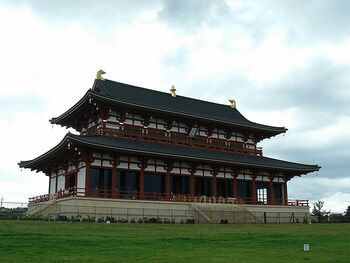Difference between revisions of "Nara Period"
| Line 1: | Line 1: | ||
| + | [[File:Todaiji.jpg|right|thumb|350px|The main hall (''hondô'') at [[Todai-ji|Tôdai-ji]]]] | ||
| + | [[File:Heijo-daigokuden.jpg|right|thumb|350px|The main audience hall (''daigokuden'') of the [[Heijo Imperial Palace|Heijô Imperial Palace]] (reconstructed 2010)]] | ||
| + | * [[710]]-[[784]] ([[794]]) | ||
* Japanese: 奈良時代 ''(Nara-jidai)'' | * Japanese: 奈良時代 ''(Nara-jidai)'' | ||
| − | |||
| − | The Nara period takes its name from the site | + | The Nara period takes its name from the site of [[Heijo-kyo|Heijô-kyô]] in present day [[Nara]], which served as the imperial capital from [[710]] until [[784]]. |
| + | |||
| + | This period continued to witness the importation and adaptation of Chinese and Korean imperial and religious culture. It saw the expansion of Buddhist influence at the court, and both the ''[[Nihon Shoki]]'' and ''[[Kojiki]]'' were completed in the early Nara period. The period saw the rise of the [[Fujiwara clan|Fujiwara family]], as well as military conflict, famine, and disease. | ||
| + | |||
| + | The capital was relocated to [[Nagaoka-kyo|Nagaoka-kyô]], a short distance north, in [[784]]. The chief impetus for this is typically cited as being a desire to escape the growing political influence of entrenched Buddhist institutions, including [[Todai-ji|Tôdai-ji]] and [[Kofuku-ji|Kôfuku-ji]]. | ||
| − | + | The capital was moved to [[Nagaoka-kyo|Nagaoka-kyô]] in [[784]], but since the Imperial Court only remained there for ten years before moving to [[Heian-kyo|Heian-kyô]] (i.e. [[Kyoto]]), these ten years are generally included into the Nara Period, prior to the start of the [[Heian Period]] in [[794]]. | |
==History== | ==History== | ||
| Line 20: | Line 26: | ||
|} | |} | ||
</center> | </center> | ||
| + | |||
| + | ==References== | ||
| + | *Conrad Schirokauer, David Lurie, and Suzanne Gay, ''A Brief History of Japanese Civilization'', Wadsworth Cengage (2013), 30-43. | ||
[[Category:Nara Period|*]] | [[Category:Nara Period|*]] | ||
[[Category:Historical Periods]] | [[Category:Historical Periods]] | ||
Revision as of 17:00, 25 September 2013


The Nara period takes its name from the site of Heijô-kyô in present day Nara, which served as the imperial capital from 710 until 784.
This period continued to witness the importation and adaptation of Chinese and Korean imperial and religious culture. It saw the expansion of Buddhist influence at the court, and both the Nihon Shoki and Kojiki were completed in the early Nara period. The period saw the rise of the Fujiwara family, as well as military conflict, famine, and disease.
The capital was relocated to Nagaoka-kyô, a short distance north, in 784. The chief impetus for this is typically cited as being a desire to escape the growing political influence of entrenched Buddhist institutions, including Tôdai-ji and Kôfuku-ji.
The capital was moved to Nagaoka-kyô in 784, but since the Imperial Court only remained there for ten years before moving to Heian-kyô (i.e. Kyoto), these ten years are generally included into the Nara Period, prior to the start of the Heian Period in 794.
History
Need more information...
| Previous Period Asuka Period |
Nara Period | Following Period Heian Period |
References
- Conrad Schirokauer, David Lurie, and Suzanne Gay, A Brief History of Japanese Civilization, Wadsworth Cengage (2013), 30-43.